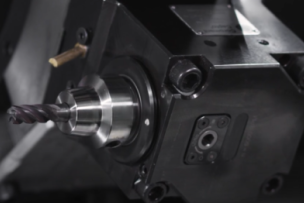Sandvik Coromant is the world’s leading supplier of tools, tooling solutions and know-how to the metalworking industry. With extensive investments in research and development they create unique innovations and set new productivity standards together with their customers. These include the world's major automotive, aerospace and energy industries.
Defining “high performance” in machining depends on the material and the total cost of operation. The objective and needs of the job should help shape the tooling decisions, finds Sandvik Coromant.
It may be time to rethink how tooling decisions are made. Is the cost of an individual tool the most important factor? The major share of costs in manufacturing are in labor and machinery. Tooling costs only account for 3 percent of the total costs.
If making parts efficiently and with the highest quality are important drivers to production, then choosing the right tool for the material can make a huge difference.
In this previously published article from Chris McDonald, a round tool specialist at Sandvik Coromant, he contends that while the term “high performance” is used to mean many different things, ultimately it pays to understand: the details of each job, the nuances of materials being cut and opportunities for standardization. The following is McDonald’s article for Sandvik Coromant:
High performance. It’s a term we see and hear often in today’s metalworking world. This term has grown to be so pervasive that a recent perusal of an industry publication delivered a surprising result. Of ten ads for production tooling (not services), seven of them used the term “high performance” when describing their product.
High performance can refer simply to the penetration rate of the drill, tool life, dimensional accuracy, surface condition of the finished bore, straightness or roundness of the hole.
The tool’s ability to work across a wide spectrum of materials can also lay claim to the title “high performance” in terms of tool versatility.
The tool selection decision maker must have a clear understanding of the benefits of the high-performance drill he is considering buying as well as the tool he needs to achieve his goal effectively and efficiently.
If a drill offers an exceptional penetration rate but the process is held up by a slower subsequent operation, has the manufacturer spent his money wisely? If the shop works in a multitude of dissimilar materials, should the purchaser buy different high-performance drills for each one, even if the shop has common sizes across the material range?
The answers to such questions can be based on annual volumes or batch sizes, and which features and benefits are of the highest priority for the shop.
Different shops and even different industries will rank cutting tool benefits in different ways. For automotive parts manufacturers working in a single material, cycle time often trumps all, followed closely by tool life. For holes in the plastic injection molding world, surface finish in the bore may be an important criteria, far outranking cycle time as a key criteria. For aerospace and medical industries, dimensional accuracy might be the defining feature.
Since high performance can mean many things to many people, OEM’s can tailor their purchases to solve their problems in their specific materials.
The job shop can be a totally different environment. While the business might be centered around a single customer or industry in which the material variety is limited, it is also possible that the shop must be a master of all materials.
It could be asked to work in low carbon steel in the morning, aircraft grade aluminum in the afternoon, and tomorrow a client could call for a quote for a job in stainless steel.
As previously mentioned, depending on the piece volume of the job, it is conceivable that the shop could buy the best drill for that particular job, in that particular material.
However, it is also possible that the job volume is too small to warrant an investment in a tool that will deliver thousands of holes, when the job itself has only 100 holes.
In the latter scenario, a shop or subcontractor might be better off selecting a high quality, multi-material drill as the shop standard. His tooling would be useable on any job that came through the door, but he could upgrade his position if the details of a particular job dictate.
High performance can mean different things to different people. While the cutting tool manufacturers continue to develop increasingly capable tools, it remains the responsibility of the end user to determine which feature of a high-performance drill will align with the shop’s needs.
This article was previously published at Shop Metalworking Technology.
Learn more about Sandvik Coromant products here.







Talk to Us!
Leave a reply
Your email address will not be published. Required fields are marked *